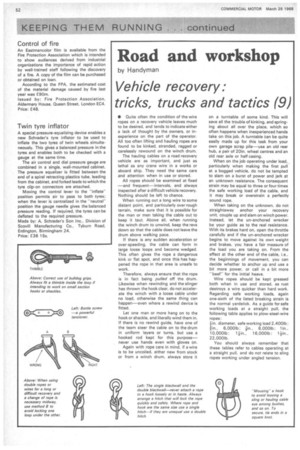Road and workshop
Page 62

If you've noticed an error in this article please click here to report it so we can fix it.
by Handyman
Vehicle recovery: tricks, trucks and tactics (9)
• Quite often the condition of the wire ropes on a recovery vehicle leaves much to be desired, and tends to indicate either a lack of thought by the owners, or inexperience on the part of the operator. All too often lifting and hauling ropes are found to be kinked, stranded, ragged or carelessly rewound on the winch drum.
The hauling cables on a road recovery vehicle are as important, and just as lethal as any crane wire in a works or aboard ship. They need the same care and attention when in use or stored.
All ropes should be examined at fixed —and frequent—intervals, and always inspected after a difficult vehicle recovery. Nothing should be left to chance.
When running out a long wire to some distant point, and particularly over rough terrain, make sure that it is possible for the man or men taking the cable out to keep it taut. Above all, when running the winch drum to unwind, keep the revs down so that the cable does not leave the drum above walking pace.
If there is any sudden acceleration or over-speeding, the cable can form in large loose loops and become wedged. This often gives the rope a dangerous kink or flat spot, and once this has happened the rope in that area is unsafe to work.
Therefore, always ensure that the rope is in fact being pulled off the drum. Likewise when rewinding and the slinger has thrown the hook clear, do not accelerate the winch with a loose cable under no load, otherwise the same thing can happen—even where a rewind device is fitted.
Let one man or more hang on to the hook or shackle, and literally wind them in. If there is no rewind guide, have one of the team steer the cable on to the drum in uniform layers or turns, but use a hooked rod kept for this purpose— never use hands even with gloves on.
Again with rope care in mind, if a wire is to be uncoiled, either new from stock or from a winch drum, always store it on a turntable of some kind. This will save all the trouble of kinking, and springing about all over the place, which so often happens when inexperienced hands take on this job. A turntable 'can be quite easily made up for this task from your own garage scrap pile—use an old rear hub, a pair of 20in. wheel centres and an old rear axle or half casing.
When on the job operating under load, particularly when making the first pull at a bogged vehicle, do not be tempted to slam on a burst of power and jerk at an unknown resistance. The consequent strain may be equal to three or fourtimes the safe working load of the cable, and it may break or overstrain a perfectly sound rope.
When taking on the unknown, do not straightaway anchor your recovery unit, couple up and slam on winch power. Instead, let the un-anchored wrecker be your guide as to the real resistance. With its brakes hard on, open the throttle carefully and if the un-anchored wrecker begins to move against its own weight and brakes, you have a fair measure of the load you are taking on. From the effect at the other end of the cable, i.e., the beginnings of movement, you can decide whether to anchor up and use a bit more power, or call in a bit more "beef" for the initial heave.
Wire ropes should be kept greased both when in use and stored, as rust destroys a wire quicker than hard work. Regarding safe working loads, again one-sixth of the listed breaking strain is the normal yardstick. As a guide for safe working loads at a straight pull, the following table applies to plow-steel-wire ropes:
'in. diameter, safe working load 2,4001b; fin., 6,000lb 4in., 8,000lb; lin.,
10,000lb ; 16,000Ib; 1 lin., 22,0001b.
You should always remember that these tables refer to cables operating at a straight pull, and do not relate to sling ropes working under angled tension.
























































































































